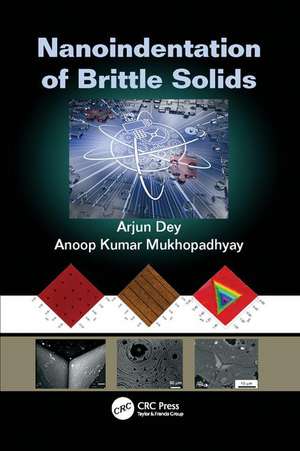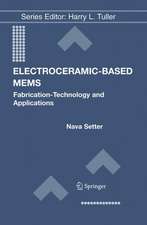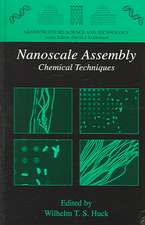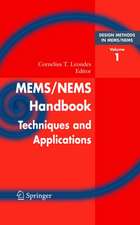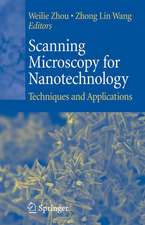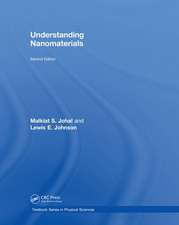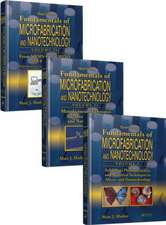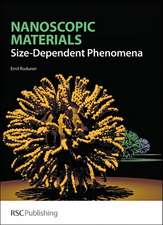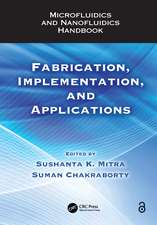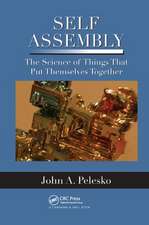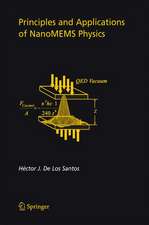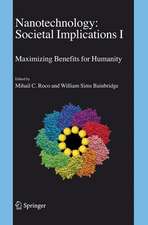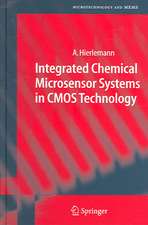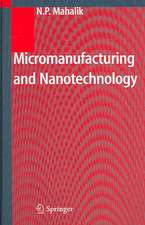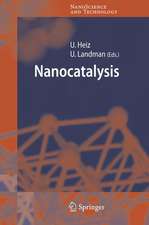Nanoindentation of Brittle Solids
Autor Arjun Dey, Anoop Kumar Mukhopadhyayen Limba Engleză Paperback – 29 mar 2017
Contact damage induced brittle fracture is a common problem in the field of brittle solids. In the case of both glass and ceramics—and as it relates to both natural and artificial bio-materials—it has triggered the need for improved fabrication technology and new product development in the industry.
The Nanoindentation Technique Is Especially Dedicated to Brittle Materials
Nanoindentation of Brittle Solids highlights the science and technology of nanoindentation related to brittle materials, and considers the applicability of the nanoindentation technique. This book provides a thorough understanding of basic contact induced deformation mechanisms, damage initiation, and growth mechanisms. Starting from the basics of contact mechanics and nanoindentation, it considers contact mechanics, addresses contact issues in brittle solids, and explores the concepts of hardness and elastic modulus of a material. It examines a variety of brittle solids and deciphers the physics of deformation and fracture at scale lengths compatible with the microstructural unit block.
- Discusses nanoindentation data analysis methods and various nanoindentation techniques
- Includes nanoindentation results from the authors’ recent research on natural biomaterials like tooth, bone, and fish scale materials
- Considers the nanoindentation response if contact is made too quickly in glass
- Explores energy issues related to the nanoindentation of glass
- Describes the nanoindentation response of a coarse grain alumina
- Examines nanoindentation on microplasma sprayed hydroxyapatite coatings
Preț: 585.27 lei
Preț vechi: 688.56 lei
-15% Nou
Puncte Express: 878
Preț estimativ în valută:
111.99€ • 116.93$ • 92.69£
111.99€ • 116.93$ • 92.69£
Carte tipărită la comandă
Livrare economică 04-18 aprilie
Preluare comenzi: 021 569.72.76
Specificații
ISBN-13: 9781138076532
ISBN-10: 1138076538
Pagini: 476
Ilustrații: Approx. 40 to 60 equations; 10 Tables, black and white; 24 Illustrations, color; 189 Illustrations, black and white
Dimensiuni: 156 x 234 x 24 mm
Greutate: 0.45 kg
Ediția:1
Editura: CRC Press
Colecția CRC Press
ISBN-10: 1138076538
Pagini: 476
Ilustrații: Approx. 40 to 60 equations; 10 Tables, black and white; 24 Illustrations, color; 189 Illustrations, black and white
Dimensiuni: 156 x 234 x 24 mm
Greutate: 0.45 kg
Ediția:1
Editura: CRC Press
Colecția CRC Press
Cuprins
Section 1 Contact Mechanics. Contact Issues in Brittle Solids. Mechanics of Elastic and Elastoplastic Contacts. Section 2 Journey Towards Nanoindentation. Brief History of Indentation. Hardness and Elastic Modulus. Nanoindentation: Why at All and Where?. Nanoindentation Data Analysis Methods. Nanoindentation Techniques. Instrumental Details. Materials and Measurement Issues. Section 3 Static Contact Behavior of Glass. What If the Contact is Too Quick in Glass?. Enhancement in Nanohardness of Glass: Possible?. Energy Issues in Nanoindentation. Section 4 Dynamic Contact Behavior of Glass. Dynamic Contact Damage in Glass. Does the Speed of Dynamic Contact Matter?. Nanoindentation Inside the Scratch: What Happens?. Section 5 Static Contact Behavior of Ceramics. Nanomechanical Properties of Ceramics. Does the Contact Rate Matter for Ceramics?. Nanoscale Contact in Ceramics. Section 6 Static Behavior of Shock-Deformed Ceramics. Shock Deformation of Ceramics. Nanohardness of Alumina. Interaction of Defects with Nanoindents in Shocked Ceramics. Effect of Shock Pressure on ISE: A Comparative Study. Section 7 Nanoindentation Behavior of Ceramic-Based Composites. Nano/Micromechanical Properties of C/C and C/C-SiC Composites. Nanoindentation on Multilayered Ceramic Matrix Composites. Nanoindentation of Hydroxyapatite-Based Biocomposites. Section 8 Nanoindentation Behavior of Functional Ceramics. Nanoindentation of Silicon. Nanomechanical Behavior of ZTA. Nanoindentation Behavior of Actuator Ceramics. Nanoindentation of Magnetoelectric Multiferroic Material. Nanoindentation Behavior of Anode-Supported Solid Oxide Fuel Cell. Nanoindentation Behavior of High-Temperature Glass–Ceramic Sealants for Anode-Supported Solid Oxide Fuel Cell. Section 9 Static Contact Behavior of Ceramic Coatings. Nanoindentation on HAp Coating. Weibull Modulus of Ceramic Coating. Anisotropy in Nanohardness of Ceramic Coating. Fracture Toughness of Ceramic Coating Measured by Nanoindentation. Effect of SBF Environment on Nanomechanical and Tribological Properties of Bioceramic Coating. Nanomechanical Behavior of Ceramic Coatings Developed by Micro Arc Oxidation. Section 10 Static Contact Behavior of Ceramic Thin Films. Nanoindentation Behavior of Soft Ceramic Thin Films: Mg(OH)2. Nanoindentation Study on Hard Ceramic Thin Films: TiN. Nanoindentation Study on Sputtered Alumina Films for Spacecraft Application. Nanomechanical Behavior of Metal-Doped DLC Thin Films. Section 11 Nanoindentation Behavior on Ceramic-Based Natural Hybrid Nanocomposites. Orientational Effect in Nanohardness of Tooth Enamel. Slow or Fast Contact: Does it Matter for Enamel?. Anisotropy of Modulus in Cortical Bone. Nanoindentation of Fish Scale. Section 12 Some Unresolved Issues in Nanoindentation. Indentation Size Effect (ISE) and Reverse Indentation Size Effect (RISE) in Nanoindentation. Pop-in Issues in Nanoindentation. Effect of Loading Rate on Nanoindentation Response of Brittle Solids. Measurement of Residual Stress by Nanoindentation Technique. Reliability Issues in Nanoindentation Measurements. Substrate Effect in ThinFilm Measurements. Future Scope of Novel Nanoindentation Technique. Conclusions. Common Abbreviations. Index.
Recenzii
"This book is written in a very colloquial style and subdivided into many small sections each with a different group of authors… The emphasis is very much on the use of pointed indenters to investigate the micro and nano-mechanical properties of brittle materials. The strength of the book is the wide range of brittle materials that the book covers. It also provides the basis upon which the science of nano or instrumented indentation mechanics is based. … a convenient reference book for students and researchers in the area of brittle materials."
––Michael Swain, Biomaterials, The University of Sydney, Australia
"The book covers a wide range of topics and as such can attract a wide variety of the audience. … for insight of practical issues that are encountered when dealing with nanoindentation and brittle materials. It can also serve as a valuable source of references in the field."
––Jiri Nemecek, Czech Technical University in Prague
"… a simple but powerful resource for students, researchers and faculty who want to work in areas of emerging materials needs in fields of space, defense, biomedical, etc."
—Dr. Satyam Priyadarshy, ReIgnite Strategy / Georgetown University
––Michael Swain, Biomaterials, The University of Sydney, Australia
"The book covers a wide range of topics and as such can attract a wide variety of the audience. … for insight of practical issues that are encountered when dealing with nanoindentation and brittle materials. It can also serve as a valuable source of references in the field."
––Jiri Nemecek, Czech Technical University in Prague
"… a simple but powerful resource for students, researchers and faculty who want to work in areas of emerging materials needs in fields of space, defense, biomedical, etc."
—Dr. Satyam Priyadarshy, ReIgnite Strategy / Georgetown University
Notă biografică
Dr. Arjun Dey is a scientist at the Thermal System Group of ISRO Satellite Centre, Bangalore. Dr. Dey earned a bachelor’s in mechanical engineering in 2003, followed by a master’s in materials engineering from Bengal Engineering and Science University, Shibpur, Howrah in 2007. While working at CSIR-Central Glass and Ceramic Research Institute (CSIR-CGCRI), Kolkata, he earned his doctoral degree in materials science and engineering in 2011 from the Bengal Engineering and Science University, Shibpur, Howrah. The research work of Dr. Dey culminated in more than 120 publications to his credit.
Dr. Anoop Kumar Mukhopadhyay is a chief scientist and head of the Mechanical Property Evaluation Section in the Materials Characterization Division of CSIR-CGCRI, Kolkata, India. He also heads the Program Management Division and Business Development Group of CSIR-CGCRI. He obtained his bachelor’s degree with honours in physics from Kalyani University, Kalyani in 1978 followed by a master’s degree in physics from Jadavpur University, Kolkata in 1982. Dr. Mukhopadhyay has written nearly 200 publications including SCI journals, national and international conference proceedings. He has written seven patents and published three book chapters.
Dr. Anoop Kumar Mukhopadhyay is a chief scientist and head of the Mechanical Property Evaluation Section in the Materials Characterization Division of CSIR-CGCRI, Kolkata, India. He also heads the Program Management Division and Business Development Group of CSIR-CGCRI. He obtained his bachelor’s degree with honours in physics from Kalyani University, Kalyani in 1978 followed by a master’s degree in physics from Jadavpur University, Kolkata in 1982. Dr. Mukhopadhyay has written nearly 200 publications including SCI journals, national and international conference proceedings. He has written seven patents and published three book chapters.
Descriere
Glass and ceramics are brittle in nature, but are often used in electronics, space, defense, biomedical, and many day-to-day applications, where mechanical disintegration may cause total failure of the application. Evaluation and in-depth knowledge of nanomechanical characterization helps to improve process parameters or may help identify the critical failure point. Therefore, it is important to measure mechanical properties such as hardness and Young’s modulus at the local microstructural length scale. This book presents a collection of recent research findings of nanoindentation issues in brittle materials.
